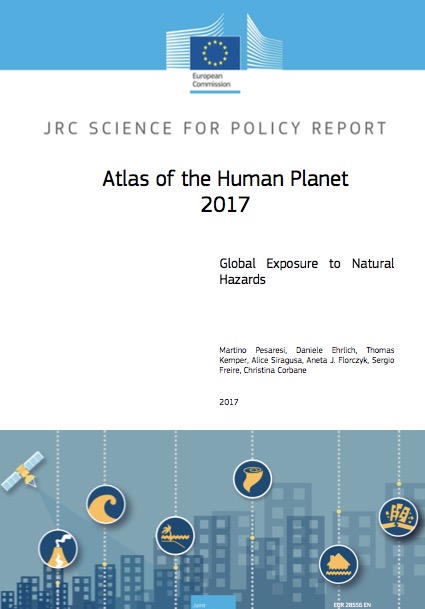New Research Resource: “Atlas of the Human Planet 2017: Global Exposure to Natural Hazards”
Atlas of the Human Planet 2017: Global Exposure to Natural Hazards was published earlier this month by the European Commission’s Joint Research Centre (JRC). It runs 92 pages (PDF) and is free to download.
A paper (fee-based) version of the book is listed in the EU Bookshop catalog but is currently shows “unavailable”.
 Title
Title
Atlas of the Human Planet 2017: Global Exposure to Natural Hazards
Authors
Daniele Ehrlich
Thomas Kemper
Alice Siragusa
Aneta J. Florczyk
Sergio Freire
Christina Corbane
Source
Joint Research Centre (JRC), European Commission
doi: 10.2760/19837
Abstract
The Atlas of the Human Planet 2017. Global Exposure to Natural Hazards summarizes the global multi-temporal analysis of exposure to six major natural hazards: earthquakes, volcanoes, tsunamis, floods, tropical cyclone winds, and sea level surge. The exposure focuses on human settlements assessed through two variables: the global built-up and the global resident population. The two datasets are generated within the Global Human Settlement Project of the Joint Research Centre. They represent the core dataset of the Atlas of the Human Planet 2016 which provides empirical evidence on urbanization trends and dynamics. The figures presented in the Atlas 2017 show that exposure to natural hazards doubled in the last 40 years, both for built-up area and population.
Earthquake is the hazard that accounts for the highest number of people potentially exposed. Flood, the most frequent natural disaster, potentially affects more people in Asia (76.9% of the global population exposed) and Africa (12.2%) than in other regions. Tropical cyclone winds threaten 89 countries in the world and the population exposed to cyclones increased from 1 billion in 1975 up to 1.6 billion in 2015. The country most at risk to tsunamis is Japan, whose population is 4 times more exposed than China, the second country on the ranking. Sea level surge affects the countries across the tropical region and China has one of the largest increase of population over the last four decades (plus 200 million people from 1990 to 2015). The figures presented in the Atlas are aggregate estimates at country level.
Direct to Full Text Book (92 pages; PDF)
See Also: Review More than 100 New Open-Web Full Text Data-Rich Reports (Various Topics)
Filed under: Data Files, Journal Articles, News, Reports
About Gary Price
Gary Price (gprice@gmail.com) is a librarian, writer, consultant, and frequent conference speaker based in the Washington D.C. metro area. He earned his MLIS degree from Wayne State University in Detroit. Price has won several awards including the SLA Innovations in Technology Award and Alumnus of the Year from the Wayne St. University Library and Information Science Program. From 2006-2009 he was Director of Online Information Services at Ask.com.


